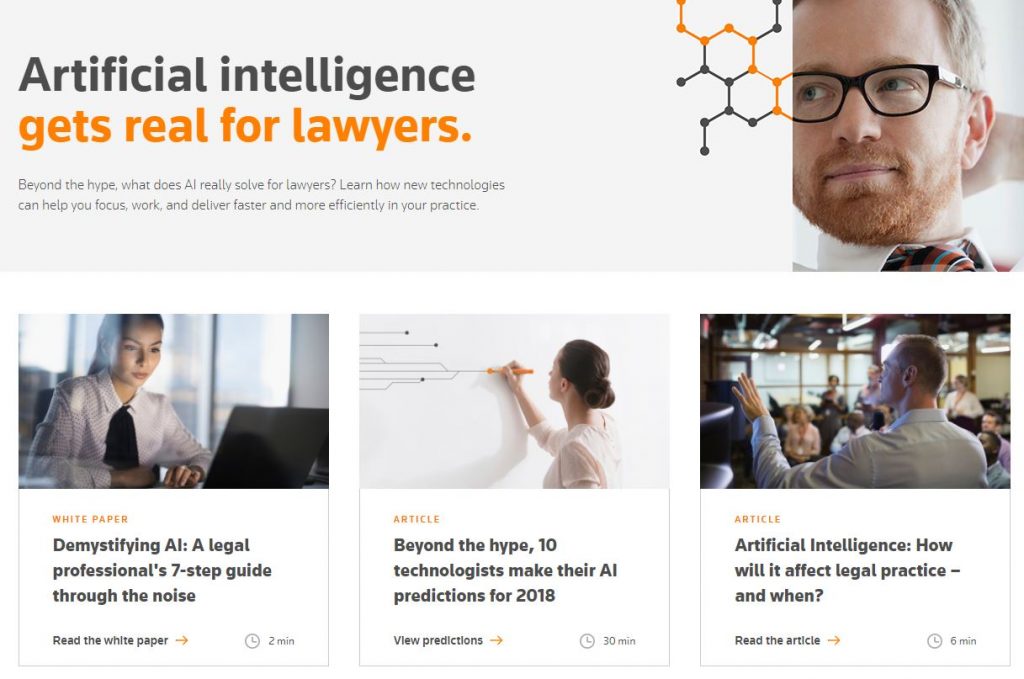Demystifying Artificial Intelligence (AI) — from legalsolutions.thomsonreuters.com
A legal professional’s 7-step guide through the noise
Excerpt:
AI IS NOT ONE THING
AI is not a single technology. Really, it’s a number of different technologies applied in different functions through various applications.
Some examples include:
Natural language processing (NLP), which is behind many AI applications in the legal industry whose work product is, as we know, text-heavy by nature. NLP is used to translate plain-English search terms into legal searches on research platforms such as Thomson Reuters Westlaw, and also to analyze language in documents to make sense of them for ediscovery or due diligence reviews.
Logical AI/inferencing is employed to build decision trees in systems such as TurboTax®. This guides users through questionnaires resulting in legal answers or drafts of legal documents. Human expertise is built into the logical structure of these systems.
This only scratches the surface of the capabilities of AI. All of the functions and technologies identified below are starting to be used in the legal space, sometimes in combination with one another.
Technologies
- Logical AI/Inferencing
- Machine Learning
- Natural Language Processing (NLP)
- Robotics
- Speech
- Vision
![]()
Functions
- Expertise Automation
- Image Recognition & Classification
- Question Answering
- Robotics
- Speech (Speech to Text, Text to Speech)
- Text Analytics (Extraction, Classification)
- Text Generation
- Translation
The meaning of artificial intelligence for legal researchers — from legalsolutions.thomsonreuters.com
Excerpt:
Many legal professionals currently use artificial intelligence (AI) in their work, although they may not always realize it. Even among the most tech-savvy attorneys, questions remain as to what AI means for the legal profession today – and in the future.
Three of the most common questions include:
- What is the definition of AI and how does it differ from other types of technology?
- How will advances in AI change the way legal professionals work in the future?
And, perhaps most importantly:
- How do you know when AI technology can be trusted in the legal space?
In this post, Thomson Reuters Westlaw shares answers to these questions based on the perspectives of our experienced attorney-editors and technology experts.
While the following isn’t necessarily related to AI, it is related to legal education and may be helpful to those who will be trying to pass the Bar Exam:
You Can Beat The Bar Exam. Here’s How. — from nationaljurist.com by Maggy Mahalick
Excerpt:
Use All Your Resources
You are not the first person to study for this exam. You are not in this alone. You don’t have to reinvent the wheel for everything. Save yourself time and energy by using resources that are already out there for you.
The National Conference of Bar Examiners (“NCBE”) has countless free and paid resources on their website alone. They provide a sample of past Multistate Essay Exam (“MEE”) questions, along with the analyses of the correct answers. They also provide a limited number of sample multiple-choice Multistate Bar Exam (“MBE”) questions with the correct answer choices for free. They provide more questions with answer explanations for a fee.
You can also sign up for a bar prep program that uses past retired questions from previous bar exams. The NCBE licenses these questions out to some companies to use instead of simulated questions. Real questions will give you an idea of what the exam will look and feel like.
If you like using flashcards but don’t have the time or patience to make your own, there are several websites that provide online flashcards for you as well as websites that allow you to make your own deck online. For example, AdaptiBar has a set of online flashcards that you can add your own notes to.









